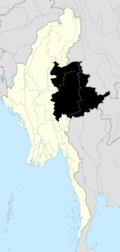Namhkam, Shan State
Namhkam | |
|---|---|
| Country | Burma |
| Admin. division | Shan State |
| Population (2005) | |
| • Ethnicities | Shan Palaung |
| • Religions | Buddhism |
Namhkam , also spelt Namkham, is a town in northern Shan State, Burma, situated on the Shweli River near the border with Yunnan Province, China.
History
The British colonial administration built a road in 1897 between this frontier town and Bhamo by the Ayeyarwady River in Kachin State, a distance of 56 miles, for Chinese muleteers in order to benefit from the border trade.[1]
During the Second World War the Allies built the Ledo Road from Ledo in Assam, India to Kunming, China across northern Burma, and by the end of 1944, completed 439 miles to Namhkam, linking up with the old Burma Road at Bhamo.[2][3] Dr Gordon Seagrave of the Burma Surgeon fame ran the US missionary hospital overlooking Namhkam.[3][4] He was believed to have had intelligence duties as well as medical.[4]
Agriculture
Cultivation of the opium poppy in the area in British times had caused considerable deforestation noted in 1920 east of a line from Lashio to Namhkam.[5]A 2005 survey carried out by the Shan State Peace Council recorded 1,800 drug addicts in Namhkam alone, and community-run rehabilitation centers were set up to tackle the rising problem of addiction. The first of these started in 1998 were declared illegal and forced to close in 2000 by the authorities.[6]Buddhist monks and teachers are also involved in the amelioration of the HIV/AIDS problem among drug users.[7]
Hsinshweli high yield hybrid rice cultivation has been promoted in recent years by the authorities in the region.[8]
Development
Burma and China signed a contract in August 2003 for a hydel power project. A dam is under construction on the Shweli River near Namhkam aiming to supply electricity to Kyaukme, Hsipaw, Lashio and Namtu.[9]The project known as Shweli 1 will supply 600 MW when completed.[10]
Politics
In 2005, an attempt by the Shan State Army-South based near the Thai border to fill the vacuum left by the 1989 cease-fire agreement between their counterparts in the north and the Burmese military was thwarted.[11][12]
Notes
- ^ Nisbet, John (1901). Burma Under British Rule and Before. Adamant Media Corporation, 2005. pp. 36–40. Retrieved 2009-03-03.
- ^ Carl Warren Weidenburner. "The Ledo Road- MILEPOSTS". University of Oklahoma Press. Retrieved 2009-03-02.
- ^ a b Win Nyunt Lwin. "Historic road links wilderness and culture". Myanmar Times October 4 - 10 , 2004. Retrieved 2009-03-04.
{{cite news}}: Italic or bold markup not allowed in:|publisher=(help) - ^ a b "World War II Timeline:Chinese struggles to provide medical care". HowStuffWorks. Retrieved 2009-03-02.
- ^ "Replacing Opium in Kokang and Wa Special Regions, Shan State, Myanmar" (PDF). UNODC. 2003. p. 6. Retrieved 2009-03-02.
- ^ "Community-run rehab centers in the north". Shan Herald Agency for News (S.H.A.N.). Retrieved 2009-03-04.
{{cite news}}: Italic or bold markup not allowed in:|publisher=(help) - ^ "HIV/AIDS education and training in Yunnan, China and the Shan State, Burma - By The [[Sangha]] Metta Project, November 2000". buddhanet.net. Retrieved 2009-03-04.
{{cite web}}: Italic or bold markup not allowed in:|publisher=(help); URL–wikilink conflict (help) - ^ "Lt-Gen Aung Htwe inspects harvesting, cultivation tasks in Namhkham". New Light of Myanmar. June 12, 2004. Retrieved 2009-03-02.
{{cite news}}: Italic or bold markup not allowed in:|publisher=(help) - ^ "Shweli Hydel Power Project". Ministry of Foreign Affairs. September 1, 2003. Retrieved 2009-03-03.
- ^ "Myanmar to implement some six hydropower projects". People's Daily online, April 21, 2007. Retrieved 2009-03-03.
{{cite news}}: Cite has empty unknown parameter:|1=(help); Italic or bold markup not allowed in:|publisher=(help) - ^ "Curfew for northern township follows rout". S.H.A.N. 2005-12-29. Retrieved 2009-03-04.
- ^ "The big chase". S.H.A.N. 2006-01-03. Retrieved 2009-03-04.


